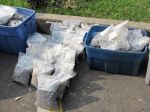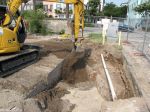Yesterday I neglected to thank Robert Behre, columnist with the Charleston Post and Courier, for his good article (and video) of the “buried treasure” that has been uncovered at the east end of Tradd Street this month. Over the past several weeks his three articles about this dig have definitely enhanced our visibility, and we appreciate the public attention given to this educational venture.
Since the digging finished yesterday, the dozen College of Charleston archaeology students helped Martha Zierden of the Charleston Museum to sort the labeled bags of artifacts accumulated during the past four weeks. Martha says the total number of ceramic sherds, bottle fragments, bone, and other items is still unclear, but it’s definitely in the thousands. A few double glazed windows in perfect condition were retrieved, it’s clear however that many windows did not get so lucky. The task of processing and preserving this material begins now and will continue for many months. This long and laborious project costs money, too, so we ask everyone to please consider donating to the Walled City Task Force or directly to the Charleston Museum in order to help Martha with this important work.
This plan for this dig was hatched by the Mayor’s Walled City Task Force many, many months ago, but it was conducted this month as a “field school” course through the College of Charleston. The students laboring here in the sun and rain over the past four weeks are receiving course credit for their work, and this morning they had their final exam. Following that somber ritual, the students and and their course leaders, Martha Zierden and Barbara Borg, gathered all the tools, equipment, supplies, and artifacts and began packing up the Museum’s old field truck. Like the end a theatrical run, the actors on this archaeological stage pitched in to strike the set and say a bittersweet goodbye to the experience.
The only task remaining was to re-cover the redan that they have worked so hard to unearth. Compared to the past four weeks of painstaking, meticulous digging and study, the process of filling the excavation units went by in the blink of an eye. For this task we turned over the stage to two familiar faces, James “Tiny” Bonnett and Leroy Young of Charleston Water System, who so ably assisted us with heavy equipment in January 2008 and again this week. Leroy brought in fresh fill dirt to cover the redan, and James gingerly directed the backhoe to move the dirt into position and tamped it down. Below are a few photos of this “finale.”
The fence and signage at the dig site will remain for a few more days, and next week the city will repave the portion of asphalt parking lot disturbed by this project.
Many visitors to the dig site have expressed dismay that we planned to fill the excavation at the end of June. Exposed to the elements, especially direct sunlight, however, the old brick and wood that we’ve been studying would rapidly begin to decay and crumble. It’s in everyone’s best interest to protect this historic site, and re-covering it offers the best short-term solution. Until such time as there is a plan for a safe and secure method of displaying or viewing the remnants of the old redan, we’ll just let it rest. Once a plan has been designed and approved, then the money must be secured to bring the plan to fruition. In the near future we’ll definitely be beating the drum to raise funds for this purpose, and we hope members of the community will express their enthusiasm for creating a window into the past by lending a hand. If you feel inclined to assist in funding such a project I encourage you to contact Katherine Saunders, co-chair of the Mayor’s Walled City Task Force and associate director of preservation at the Historic Charleston Foundation.
Don’t forget about the upcoming program at the Charleston County Public Library on Tuesday, June 30th, at 6:30 p.m. We’ll review the past four weeks of archaeology and talk about all the lessons learned during this great experience. Please come!





14 August 2009 at 4:44 am
I am currently stationed in western iraq, and I was in Charleston in June, and I was part of a walking tour and was lucky enough to see your dig. I’d really appreciate any updates you could send me to my email, good luck with your dig!..Always, Brian